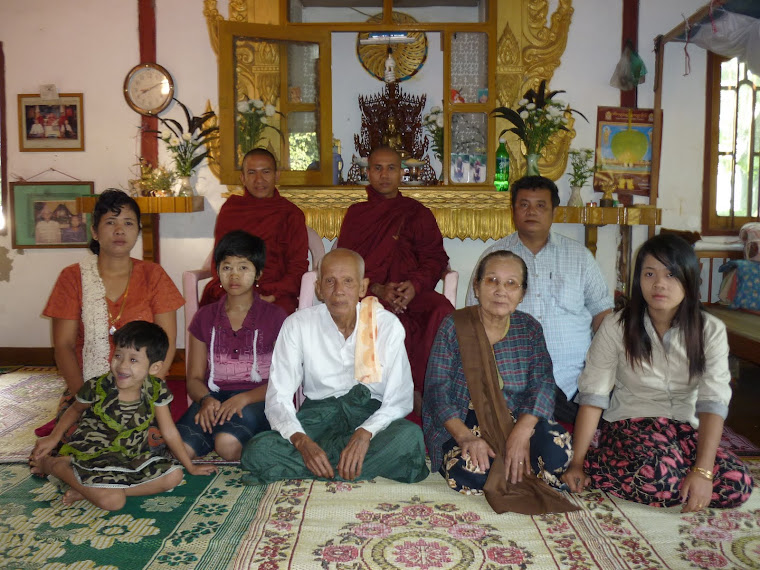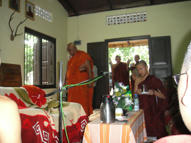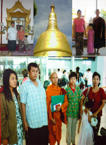The origin of religion through different kinds of approaches
Introduction
First, some philosophers of religion hold that historians of religions are essentially philosophers of religion, or they ought to be if they are not already. To them, the religion-scientific inquiry of the history of religions is an important tool to develop an adequate philosophy of religion, which transcends the regional and subjective elements involved in all religious systems. Or, to put it differently, they may say that all religions are manifestations of, or a search for, one underlying primordial "religion" and the task of the history of religions is, in co-operation with the philosophy of religion, to study the relation between religion and religions and to enlighten a confused humanity so that it will eventually move toward the absolute truth.
Second, there are those who hold that the so-called objective approach of the history of religions is not objective enough, because of the very nature of the subject matter. Thus they urge historians of religions to concentrate more on the historical, phenomenological, and institutional aspects of religions, depending heavily on the co-operation and assistance of anthropologists, sociologists, philologists, and universal as well as regional historians.
There is a third group who hold that the history of religions does not take seriously enough the subjective elements involved in the study of various religions. They sometimes compare historians of religions, uncharitably to be sure, to "flies crawling on the surface of a goldfish bowl, making accurate and complete observations on the fish inside . . . and indeed contributing much to our knowledge of the subject; but never asking themselves, and never finding out, how it feels to be a goldfish. " (Wilfred Cantwell Smith,” "The Comparative Study of Religion," Inaugural Lectures [Montreal: McGill University, 1950], p. 42.) What is important, according to this line of thinking, is to let the adherents of each religion speak for themselves about the nature of their own religious experiences, their views of the world and of life, and their own forms of beliefs and worship.
Finally, there are still others who rule out the possibility of religion-scientific approach to the study of religions on the grounds that each investigator is incurably conditioned by own religious and cultural background. On this basis they advocate the necessity of what might be termed as a theological history of religions, be it Islamic, Christian, or Hindu, as the only legitimate discipline. Closely related to this perspective is that of missionology or Missionswissenschaft, which utilizes the data and findings of Religionswissenschaft for apologetic purposes from the standpoint of Islamic, Christian, Buddhist, or Hindu faith.
All these criticisms have been raised by men and women in all walks of life. However, what concerns us particularly is the fact that the basic un-clarity of the discipline of the history of religions has created confusion regarding the place of the history of religions in the academic curriculum in this country. Generally speaking, there are three kinds of educational institutions which are concerned with the teaching of the history of religions. In the undergraduate colleges and universities the question of the history of religions is discussed in connection with the problem of the teaching of religion. In the graduate institutions questions are raised as to the legitimacy of the history of religions as an academic discipline, and also the relations of the research method to other disciplines. In the theological schools and seminaries, the questions of the history of religions are involved in the relations of Buddhism to other religions.
It must be made abundantly clear that the history of religions is not proposed as the only valid method of studying religions. Actually, it is only one among many different approaches, such as philosophy of religion, psychology of religion, sociology of religion, and theology. Unlike philosophy of religion and theology, however, the history of religions does not "indorse" any particular system offered by the diverse religions of the world, nor does it advocate, as many ultra-liberals think it ought, any new universal synthetic religion. On the other hand, there are those who study other religions much as the commander of an invading army investigates enemy territory, and with much the same motivations. Such an approach is, of course, not acceptable to the history of religions, for this discipline does not prove the superiority of any particular religion over others.
There are three essential qualities underlying the discipline of the history of religions: First is a sympathetic understanding of religions other than one’s own. Second is an attitude of self-criticism, or even skepticism, about one’s own religious background. And third is the "scientific" temper.
Historically, the encounter of different peoples and religions has often resulted in serious conflicts and the subjugation of one group by another, but in some cases it has also fostered sympathetic understanding and mutual respect among individuals of different backgrounds. Sometimes, knowledge of other religions, or a crisis in one’s life, leads one to question one’s own religious faith. Therefore, they are the origin of religion through different kinds of approach in the introduction.
I m grateful to professor for his kindness in preparing the origin of religion through different kinds of approach and thank the religion of Pali Commission professor for giving to use the origin of religion through different kinds of approach prepared by my writing. I express my gratitude to professor for kindly preparing the assignment. Finally, my thanks are due to professor of B.P.U for his kind help and advice in many ways and to the origin of religion through different kinds of approach for bringing out the procedure of topic.
The origin of religion through different kinds of approaches
According to historical point of views, one cannot discuss the origin of religion through different kinds of approach without taking into the prevailing views because theory of the origin of religion is the prevailing views, religion accept the views of the highest of right understanding. These are Jiana, Brahma, Hindu, and Buddhism. Therefore these are called the origin of religion through different kinds of religion approach. Hence, historian and scholars believe that the history of the origin of religion through different kinds of an approach in India begin with Ariyan inversion until 19 century. In the same way, prehistory is a term used to describe the period before recorded history Originally coined the term Pré-historique in describing the finds he had made in the caves of southern frence It came into use in France in the 1830s to describe the time before writing, and the word "prehistoric" was introduced into English by Deniel Wilson in 1851.
The term "prehistory" can be used to refer to all time since the beginning of the universe, although it is more often used in referring to the period of time since life appeared on Earth, or even more specifically to the time since human-like beings appeared. In dividing up human prehistory, prehistorians typically use the three age system, whereas scholars of pre-human time periods typically use the well defined Rock record and its internationally defined stratum base within the geologic time scale. The three-age system is the periodization of human prehistory into three consecutive time periods, named for their respective predominant tool-making technologies; the Stone Age, bronze Age, and Iron Age. The occurrence of written materials (and so the beginning of local "historic times") varies generally to cultures classified within either the late Bronze Age or within the Iron Age. Historians increasingly do not restrict themselves to evidence from written records and are coming to rely more upon evidence from the natural and social sciences, thereby blurring the distinction between the terms "history" and "prehistory." This view has recently been articulated by advocates of deep history.
Though, the history of religion is not concerned with theological claims apart from their historical significance. Some topic of this disciplines are historicity of religious figures, events, and evolution of doctrine matters. Because, by definition, there are no written record from human being prehistory, dating are prehistoric materials is particularly crucial to the enterprise. Clear techniques for dating were not well developed until the origin of religious. The primary researches into human prehistory are historic religion of archaeologists and physical aspects of religion are anthropologists who use excavation, geologic and geographic surveys, and other religion analysis to reveal and interpret the nature and various behaviors of preliterate and non literate people. Human population geneticists and historical linguists of religious are also providing valuable inside these questions. Religion culture anthropologist’s help to provide context of married and trade, by whish object of human origin are passed among people, thereby allowing for a rich analysis of any topic that arises in a human prehistoric and the origin of religion prehistoric context. Therefore, data about prehistory is provided by an individual variety of natural and social religion, such as Buddhist biology, archaeology, geology, comparative linguistics, anthropology, and many others.
On the other hand, Buddhism is one of the world's major religions. The teachings known as the Four Noble Truths are generally recognized as the core of Buddhism. The first truth is that life is suffering. Suffering continues through an endless chain of rebirths. The second truth is that suffering is caused by desire. The third is that desire can be ended, and the fourth is that right living according to Buddhist precepts (known as the Eightfold Path) is the way to end desire. With the ceasing of desire, beings enter nirvana, a state of release from existence. The striving toward nirvana also involves dedication to the Three Jewels. The first jewel is Buddha himself. The second is the dharma, or "universal law," the truth taught by Buddha. The sangha, or community of monks, is the third.
The founder of Buddhism, Siddhārtha Gautama, also known as Gautama Śākyamuni, was born in the kingdom of the Śākyas in northeastern India. The most commonly accepted dates for his life are c. 566 to c. 486 B.C.E. During this period, India was in a state of rapid political, social, and economic change. By about 600 B.C.E., a number of republics and kingdoms had arisen in northern India, and settled towns became a prominent part of life. Trade with western Asia and other parts of the world contributed to the growth of merchant and artisan classes.
The development of new urban centers and new social classes led to a tendency to pose fundamental philosophical questions, and the time was rich in philosophical and religious teachers. One of those was Vardhamāna, the founder of India's Jain religion, who lived and taught at roughly the same time as Buddha. According to Vardhamāna, the universe works according to an eternal law and everything in the universe has a soul. The purpose of living, in Jainism, is the purification of the soul in order to release the soul from the body. Although there are important differences between Jainism and Buddhism, there are also similarities, such as the idea of universal law, adherence to the principle of nonviolence, and the view of life as a movement toward release. These similarities suggest some of the ideas that were current at the time of the birth of Buddhism.
The details of the life of Siddhārtha Gautama are based on tradition because the first written accounts of his life and actions date from about two hundred years after his death. Siddhārtha is said to have been a prince. At his birth, the Brahmans, or priests, at his father's court foretold that the prince would either become a world-conquering monarch or a Buddha, which means "awakened one" or "enlightened one" in the classical Indian language of Sanskrit. Wishing to keep his son from taking up the life of a holy man, King Śuddhodana attempted to surround the child with luxury and comfort. Nevertheless, as a young man, Gautama saw old age, sickness, and death, which convinced him of the misery of the world. He also saw a wandering holy man and was inspired to leave home to seek wisdom.
| For example, once mankind develops a sophisticated level of speech, religion of some kind cannot be far behind. Superstition is an instinct which many of us today profess to be ashamed of. But in a primitive community, among all the dangers of nature, it is little more than common sense. Clearly everything that grows and recreates itself, whether animal or plant, has a living spirit of some sort. And the wind and the water and the fire of the natural world seem far from dead, as they swirl about in their various ways. Mankind needs the cooperation of these aspects of nature. Religion, in the primitive form of animism (the need to befriend and appease the spirits within natural objects), is designed to secure it. |
|
|
| What can humans do to influence nature? Carrying out an appropriate ritual, whether in the form of dance, sacrifice or chant, seems to offer the best chance. As with any superstitious habit, a primitive religious custom is thought likely to work because it is believed to have worked in the past. A ritual, by the time anyone is aware of its ritual nature, gives the impression of having been done from time immemorial. And the proof of its power is plain for all to see. The sun has gone on rising, the bison have reproduced themselves, and these crops have come up. |































0 comments:
Post a Comment